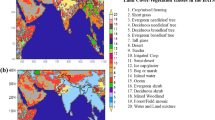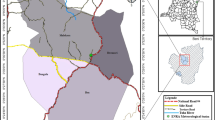Abstract
In this study, a coupled dynamical-copula downscaling approach was developed through integrating the Providing Regional Climates for Impacts Studies (PRECIS) modeling system and the copula method. This approach helps to reflect detailed features at local scales based on dynamical downscaling, while also effectively simulating the interactions between large-scale atmospheric variables (predictors) and local surface variables (predictands). The performance of the proposed approach in reproducing historical climatology of the Canadian Prairies was evaluated through comparison with observations. Future climate projections generated by the developed approach were analyzed over three time slices (i.e., the 2030s, 2050s, and 2080s) to help understand the plausible changes in temperature over the Canadian Prairies in response to global warming. The results showed that there would be an apparent increasing pattern over the Canadian Prairies. The projections of future temperature over three time slices can provide decision makers with valuable information for climate change impacts assessment over the Canadian Prairies.














Similar content being viewed by others
References
Akinremi O, McGinn S, Cutforth H (2001) Seasonal and spatial patterns of rainfall trends on the Canadian prairies. J Clim 14:2177–2182
Argüeso D, Evans JP, Fita L, Bormann KJ (2014) Temperature response to future urbanization and climate change. Clim Dyn 42:2183–2199
Asong Z, Khaliq M, Wheater H (2016) Projected changes in precipitation and Temperature over the Canadian Prairie provinces using the generalized linear model statistical downscaling approach. J Hydrol 539:429–446
Bechler A, Vrac M, Bel L (2015) A spatial hybrid approach for downscaling of extreme precipitation fields. J Geophys Res-Atmos 120:4534–4550
Boé J, Terray L, Habets F, Martin E (2007) Statistical and dynamical downscaling of the Seine basin climate for hydro-meteorological studies. Int J Climatol 27:1643–1655
Centella-Artola A, Taylor MA, Bezanilla-Morlot A, Martinez-Castro D, Campbell JD, Stephenson TS, Vichot A (2015) Assessing the effect of domain size over the Caribbean region using the PRECIS regional climate model. Clim Dyn 44:1901–1918
Chavez-Arroyo R, Lozano-Galiana S, Sanz-Rodrigo J, Probst O (2015) Statistical-dynamical downscaling of wind fields using self-organizing maps. Appl Therm Eng 75:1201–1209
Chun KP, Wheater HS, Nazemi A, Khaliq MN (2013) Precipitation downscaling in Canadian Prairie Provinces using the LARS-WG and GLM approaches. Can Water Resour J 38:311–332
Cox P, Betts R, Bunton C, Essery R, Rowntree P, Smith J (1999) The impact of new land surface physics on the GCM simulation of climate and climate sensitivity. Clim Dyn 15:183–203
deJong A, McBean E, Gharabaghi B (2010) Projected climate conditions to 2100 for Regina, Saskatchewan. Can J Civ Eng 37:1247–1260.Boschung J, Nauels A, Xia Y, Bex V, Midgley, Eds:1535
Environment and Climate Change Canada (2015) Historical data. http://climate.weather.gc.ca/historical_data/search_historic_data_e.html. Accessed 15 April 2017
Fan YR, Huang G, Li YP, Kong XM (2016) Bivariate hydrologic risk analysis based on coupled entropy-copula method for the Xiangxi River in Three Gorges Reservoir Area, China. Theoret Appl Climatol 125(1):381–397
Fan YR, Huang G, Baetz BW, Li YP, Huang K (2017). Development of Copula-based Particle Filter (CopPF) approach for hydrologic data assimilation under consideration of parameter interdependence. Water Resour Res. https://doi.org/10.1002/2016WR020144
Gameda S, Qian B, Campbell C, Desjardins R (2007) Climatic trends associated with summerfallow in the Canadian Prairies. Agric For Meteorol 142:170–185
Genest C, Favre A-C (2007) Everything you always wanted to know about copula modeling but were afraid to ask. J Hydrol Eng 12:347–368
Genest C, Rémillard B, Beaudoin D (2009) Goodness-of-fit tests for copulas: a review and a power study. Insurance: Math Econ 44:199–213
Gong W, Duan QY, Li DJ, Wang C, Di ZH, Ye AZ, Miao CY, Dai YJ (2015) An intercomparison of sampling methods for uncertainty quantification of environmental dynamic models. J Environ Inform. https://doi.org/10.3808/jei.201500310
Gregory D, Rowntree P (1990) A mass flux convection scheme with representation of cloud ensemble characteristics and stability-dependent closure. Mon Weather Rev 118:1483–1506
Gringorten II (1963) A plotting rule for extreme probability paper. J Geophys Res 68:813–814
Hellström C, Chen D (2003) Statistical downscaling based on dynamically downscaled predictors: application to monthly precipitation in Sweden. Adv Atmos Sci 20:951–958
Hessami M, Gachon P, Ouarda TB, St-Hilaire A (2008) Automated regression-based statistical downscaling tool. Environ Model Softw 23:813–834
IPCC (2013) Climate change 2013: the physical science basis. In: Stocker TF, Qin D, Plattner G-K, Tignor M, Allen SK, Boschung J, Nauels A, Xia Y, Bex V, Midgley PM (eds) Contribution of working group I to the fifth assessment report of the Intergovernmental Panel on Climate Change. Cambridge University Press, Cambridge, pp. 1535
Jeong DI, Sushama L, Khaliq MN, Roy R (2014) A copula-based multivariate analysis of Canadian RCM projected changes to flood characteristics for northeastern Canada. Clim Dyn 42:2045–2066
Jones R, Hassell D (2004) Generating high resolution climate change scenarios using PRECIS. Met Office Hadley Centre, Exeter
Jones R, Noguer M, Hassell D, Hudson D, Wilson S, Jenkins G, Mitchell J (2004) Generating high resolution climate change scenarios using PRECIS. Met Office Hadley Centre, Exeter
Jury MW, Prein AF, Truhetz H, Gobiet A (2015) Evaluation of CMIP5 models in the context of dynamical downscaling over Europe. J Clim 28:5575–5582
Karmakar S, Simonovic S (2009) Bivariate flood frequency analysis. Part 2: a copula-based approach with mixed marginal distributions. J Flood Risk Manag 2:32–44
Kim HM, Chang EKM, Zhang MH (2015) Statistical-Dynamical seasonal forecast for tropical cyclones affecting New York State. Weather Forecast 30:295–307
Li R, Wang SY, Gillies RR (2016) A combined dynamical and statistical downscaling technique to reduce biases in climate projections: an example for winter precipitation and snowpack in the western United States. Theoret Appl Climatol 124:281–289
Moss RH, Edmonds JA, Hibbard KA, Manning MR, Rose SK, Van Vuuren DP, Carter TR, Emori S, Kainuma M, Kram T (2010) The next generation of scenarios for climate change research and assessment. Nature 463:747–756
Natural Resources Canada (2015) Introduction—Prairies. http://www.nrcan.gc.ca/environment/resources/publications/impacts-adaptation/reports/assessments/2008/ch7/10381. Accessed 15 April 2017
Nelsen RB (2007) An introduction to copulas. Springer Science & Business Media, Berlin
Notaro M, Bennington V, Lofgren B (2015) Dynamical downscaling—based projections of Great Lakes Water levels. J Clim 28:9721–9745
PaiMazumder D, Sushama L, Laprise R, Khaliq MN, Sauchyn D (2013) Canadian RCM projected changes to short-and long-term drought characteristics over the Canadian Prairies. Int J Climatol 33:1409–1423
Pérez JC, Díaz JP, González A, Expósito J, Rivera-López F, Taima D (2014) Evaluation of WRF parameterizations for dynamical downscaling in the Canary Islands. J Clim 27:5611–5631
Piani C, Haerter J, Coppola E (2010) Statistical bias correction for daily precipitation in regional climate models over Europe. Theoret Appl Climatol 99:187–192
Quintana-Seguí P, Peral C, Turco M, Llasat MC, Martin E (2016) Meteorological analysis systems in north-east Spain: validation of SAFRAN and SPAN. J Environ Inform 27(2):116–130. https://doi.org/10.3808/jei.201600335
Reyers M, Pinto JG, Moemken J (2015) Statistical-dynamical downscaling for wind energy potentials: evaluation and applications to decadal hindcasts and climate change projections. Int J Climatol 35:229–244
Salvadori G, De Michele C, Kottegoda NT, Rosso R (2007) Extremes in nature: an approach using copulas. Springer Science & Business Media, Berlin
Shepherd A, McGinn SM (2003) Assessment of climate change on the Canadian prairies from downscaled GCM data. Atmos Ocean 41:300–316
Skinner W, Gullett D (1993) Trends of daily maximum and minimum temperature in Canada during the past century. Climatol Bull 27:63–77
Skinner WR, Majorowicz JA (1999) Regional climatic warming and associated twentieth century land-cover changes in north-western North America. Climate Res 12:39–52
Sraj M, Bezak N, Brilly M (2015) Bivariate flood frequency analysis using the copula function: a case study of the Litija station on the Sava River. Hydrol Process 29:225–238
Statistics Canada (2015) Population by year, by province and territory (Number). http://www.statcan.gc.ca/tables-tableaux/sum-som/l01/cst01/demo02a-eng.htm. Accessed 15 April 2017
Sun F, Walton DB, Hall A (2015) A hybrid dynamical—statistical downscaling technique. Part II: end-of-century warming projections predict a New Climate State in the Los Angeles region. J Clim 28:4618–4636
Tang JP, Niu XR, Wang SY, Gao HX, Wang XY, Wu J (2016) Statistical downscaling and dynamical downscaling of regional climate in China: present climate evaluations and future climate projections. J Geophys Res-Atmos 121:2110–2129
Van Vuuren DP, Edmonds J, Kainuma M, Riahi K, Thomson A, Hibbard K, Hurtt GC, Kram T, Krey V, Lamarque J-F (2011) The representative concentration pathways: an overview. Clim Change 109:5–31
Walton DB, Sun F, Hall A, Capps S (2015) A hybrid dynamical—statistical downscaling technique. Part I: development and validation of the technique. J Clim 28:4597–4617
Wang X, Huang GH, Lin Q, Nie X, Cheng G, Fan Y, Li Z, Yao Y, Suo M (2013) A stepwise cluster analysis approach for downscaled climate projection—a Canadian case study. Environ Modell Softw 49:141–151
Wang X, Huang GH, Lin Q, Liu J (2014) High-resolution probabilistic projections of temperature changes over Ontario, Canada. J Clim 27:5259–5284
Wang X, Huang GH, Lin Q, Nie X, Liu J (2015a) High-resolution temperature and precipitation projections over Ontario, Canada: a coupled dynamical-statistical approach. Quart J R Meteorol Soci 141:1137–1146
Wang X, Huang GH, Liu J, Li Z, Zhao S (2015b) Ensemble projections of regional climatic changes over Ontario. Can J Clim 28:7327–7346
Willmott CJ, Matsuura K (2005) Advantages of the mean absolute error (MAE) over the root mean square error (RMSE) in assessing average model performance. Clim Res 30:79–82
Wilson S, Hassell D, Hein D, Jones R, Taylor R (2005) Installing and using the Hadley Centre regional climate modelling system. PRECIS Version 1:157
Zhang L (2005) Multivariate hydrological frequency analysis and risk mapping, Beijing Normal University, Beijing
Zhang L, Singh V (2006) Bivariate flood frequency analysis using the copula method. J Hydrol Eng 11:150–164
Zhou X, Huang GH, Zhu H, Cheng J, Xu JL (2015a) Chance-constrained two-stage fractional optimization for planning regional energy systems in British Columbia, Canada. Appl Energy 154:663–677. https://doi.org/10.1016/j.apenergy.2015.05.013
Zhou X, Huang GH, Wang X, Cheng G (2017) Dynamically-downscaled temperature and precipitation changes over Saskatchewan using the PRECIS model. Clim Dyn 1–14. https://doi.org/10.1007/s00382-017-3687-9
Zollo AL, Turco M, Mercogliano P (2015) Assessment of hybrid downscaling techniques for precipitation over the Po River Basin. In: Lollino G, Manconi A, Clague J, Shan W, Chiarle M (eds) Engineering geology for society and territory - volume 1: climate change and engineering geology. Springer International Publishing, Cham, pp. 193–197
Acknowledgements
This research was supported by the National Key Research and Development Plan (2016YFA0601502, 2016YFC0502800), the Natural Sciences Foundation (51520105013, 51679087), the 111 Program (B14008) and the Natural Science and Engineering Research Council of Canada.
Author information
Authors and Affiliations
Corresponding author
Rights and permissions
About this article
Cite this article
Zhou, X., Huang, G., Wang, X. et al. A coupled dynamical-copula downscaling approach for temperature projections over the Canadian Prairies. Clim Dyn 51, 2413–2431 (2018). https://doi.org/10.1007/s00382-017-4020-3
Received:
Accepted:
Published:
Issue Date:
DOI: https://doi.org/10.1007/s00382-017-4020-3




